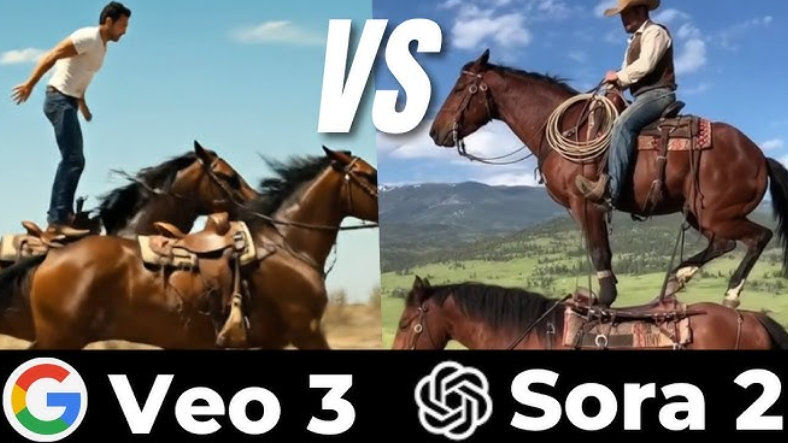In a rapidly evolving field of generative AI, two prominent models are now in direct competition: Google’s Veo 3 and OpenAI’s Sora 2. A recent hands-on review by Android Authority finds that while both have made major leaps forward, the gap between them remains noteworthy.
What’s the comparison?
The review covers a series of sample prompts — from simple scenes (“a photorealistic shot of espresso being poured into a white cup in slow motion”) to more complex scenarios (“a motorcyclist riding along a beach at sunset”, “iconic yellow taxi driving along Kolkata’s streets during a bright day”).
-
With the espresso scene, Veo 3 produced a convincingly realistic flow of liquid with natural physics; the older Sora model lagged.
-
For the motorcyclist-on-beach scenario, Veo 3 delivered a cinematic feel with realistic lighting and motion; Sora 2 still struggled with motion physics.
-
In the Kolkata taxi example, Sora 2 improved significantly, nailing atmosphere and context; Veo 3 was strong but had sliding motion issues.
Implications for users
From a user perspective—whether you’re a content creator, educator, marketer or hobbyist—these developments matter a lot.
-
Accessibility of video-creation: Tools like these bring video generation to a broader audience. Instead of needing a full production team, users can prompt text and get a usable clip. The review points out how a “single sentence prompt can now yield a full-fledged video, complete with realistic voices and even music.”
-
Quality expectations rising: As models like Veo 3 and Sora 2 raise the bar, user expectations for realism, physics-correct motion, lighting and object permanence go up. If earlier tools produced visibly “AI-ish” results, now users expect near-photoreal results.
-
Cost and access: Even the best models come with limitations. For example, Veo 3 via Google’s Gemini Pro gets “three videos per day” at the time of review. Sora 2 is free at the moment (without ChatGPT subscription) but is invite-only and likely to introduce limits once widely available. This means users need to weigh capability vs cost/availability.
-
Use-case expansion: As video generation becomes more realistic, new user sectors get impacted: educators creating visual stories, marketers spinning quick ads, small businesses producing branded content quickly. The review explicitly notes that “teachers can create visual stories for class, business owners spin quick ads for social media — the use cases feel endless.”
Broader impact on AI & frontier tech
Beyond individual users, these developments reflect broader shifts in the AI landscape, with implications for how we think about content, production, ethics and technological competition.
-
Race for generative video dominance: Google and OpenAI are now clearly jockeying for leadership in text-to-video generation. The review notes that OpenAI’s Sora upset Google’s prior “mammoth lead” in AI video. This competition is beneficial in driving innovation, but also introduces fast-moving risks (ethical, copyright, misuse).
-
Quality leaps accelerating: The move from the first-gen Sora to Sora 2 and Google’s Veo 3 shows how quickly generative tech is catching up to human-production quality — realistic motion, object permanence, cinematic lighting, believable physics. This suggests that “good enough for professional work” may become a baseline sooner than many expect.
-
Ethics, copyright and misuse concerns: As video generation becomes realistic, issues around who owns generated content, how copyright characters are handled, potential for deep-fakes, and misuse (misinformation, impersonation) become even more acute. In the review, Sora 2 refused a prompt involving a copyrighted character — showing policy/ethical constraints now embedded in models.
-
Shift in production pipelines: Traditional video production (camera crews, lighting setups, editing) might face disruption. For simpler content, users may bypass those entirely. This shifts how studios might allocate resources and perhaps redefine “production value” in a world of high-quality generative video.
-
New tech frontiers unlocked: This is not just about video-for-fun. Realistic generative video could impact training simulations, virtual production for movies and games, AR/VR content generation, even storytelling and education at scale. The frontier expands.
Challenges and things to watch
-
Model limitations still present: Although much improved, neither Veo 3 nor Sora 2 is flawless. In the review, Sora 2 still failed in some scenarios (e.g., the motorcyclist prompt) and Veo 3 had sliding motion issues in the Kolkata taxi scene.
-
Access & cost: Premium models often come locked behind subscriptions or invite-only access, which may limit democratization of the tech.
-
Ethical/regulatory frameworks lag: As generative video becomes realistic, regulation, transparency, provenance (how was the video made?) and trust become key. Users and companies will need guidelines, and policy often lags tech.
-
Misuse risk: High realism raises the stakes for misuse (deep-fakes, misinformation, impersonation). Responsible design, watermarking, detection tools matter.
-
Bandwidth, compute resource, storage: Generative video demands heavier compute, and users (especially smaller ones) might find technical/resource constraints still relevant.
خاتمة
The face-off between Google Veo 3 and OpenAI Sora 2 illustrates how generative video is entering a maturity phase — no longer primitive novelty, but becoming production-ready for many use-cases. For users, this translates into new creative capabilities and workflows, along with cost, access and ethical considerations. For the AI & frontier technology landscape, it underscores a fierce competition, accelerating innovation, and a shift in how content is created, consumed and regulated.
As these models continue to improve, we should watch closely how access evolves, how ethical frameworks keep pace, and how creators (professional and amateur) harness this wave. In short: the future of video creation is being rewritten — and users, creators and technologists alike need to sit up and take notice.








